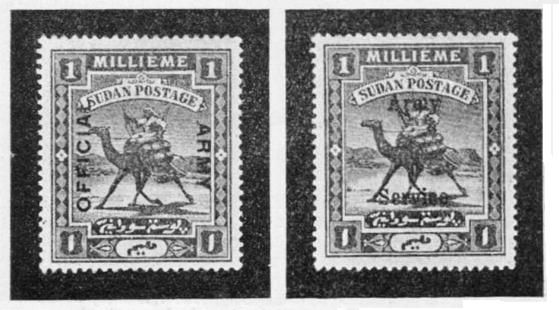 |
| Source |
The first post offices to be opened in Sudan were in 1867 at Saukin and Wadi Halfa; in 1873 at Dongala, Berber and Khartoum; and in 1877 at Sennar, Karkouk, Fazoglu, Elkedaref, El Obied, Al-Fasher and Fashod (now Kodok).
The Mahdist revolt, which began in 1881, resulted in all Egyptian post offices being closed by 1884. It culminated in the fall of Khartoum and the death of the British governor General Gordon (Gordon of Khartoum) in 1885. The Egyptians and British withdrew their forces from Sudan and the country was left with no postal service until the reconquest of Sudan began in 1896. When the campaign started in March 1896, postal service was made available to the troops but no stamps were used.
Until the issue of Sudan stamps in 1897 the available stamps were Egyptian stamps. The amount of mail was small and only a few stamps were used. Between March and July 1885 2½d and 5d British postage stamps were used in Suakin. Indian stamps are also known to have been used in the same area, postmarked Sawakin or Souakin, between 1884 and 1899.
The provisional stamps of 1897 On 1 March 1897, contemporary Egyptian postage stamps, overprinted SOUDAN in French and Arabic, were made available in the post offices. Value which appeared were 1, 2, 3 and 5 millieme and 1, 2, 5 and 10 piastre. The overprinting was done at the Imprimerie Nationale, Boulaq, Cario, Egypt.
The Camel Postman Stamps
 |
| Source |
Designed by Captain Stanton, of the Oxford Light Infantry, depicting a camel rider, alleged to be a portrait of Slatin Pasha. The rider is carrying mail, and is armed with a rifle and two spears. Stanton was an officer in Kitchener’s Army during the campaign to recapture Khartoum.
The stamps were printed by Thos De La Rue & Co were issued. This design continued to be used by Sudan for its definitive stamps until 1948.
Air Mails
 |
| Source |
 | |||||
| Source | |||||

Military Post
These stamps were overprinted for use of army officials either with the words "
OFFICIAL-ARMY", or "Army Service".
|


No comments:
Post a Comment